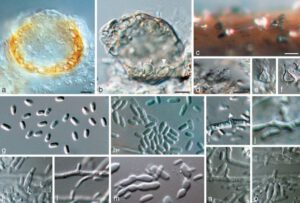Minutiella tardicola (Damm & Crous) Crous, Persoonia 34: 225 (2015)
Index Fungorum Number: IF 812474; MycoBank Number: MB 812474; Facesoffungi Number: FoF 15765
Basionym – Phaeomoniella tardicola Damm & Crous, Persoonia 24: 77. 2010.
Etymology – Named after the slow growth of the fungus (tardus Lat. = slow, -cola Lat. = growing).
Vegetative hyphae hyaline, 1–2 μm wide, septate, lacking chlamydospores. Sporulation abundant, conidia formed on hyphae and in pycnidia. Conidiophores on hyphae reduced to conidiogenous cells. Conidiogenous cells enteroblastic, reduced to mere openings formed directly on hyphal cells, rarely to short necks, discrete phialides very rare; necks 0.5–1(–5) μm long, 0.5–1 μm wide; collarettes mostly inconspicuous, opening ≤ 0.5 μm wide. Conidia 1-celled, hyaline, cylindrical to obovate, smooth-walled, 2–4.5(–7) × 1–1.5(–2) μm, mean ± SD = 3.2 ± 1.2 × 1.3 ± 0.3 μm, L/W ratio = 2.5. Microcyclic conidiation rarely observed. Conidiomata pycnidial, produced on pine needles on SNA, and on MEA in 2–4 wk, solitary, subglobose, superficial, pale to dark brown, globose to subglobose, 15–80 μm diam, unilocular, opening by irregular rupture, wall 1–2 cell layers thick, composed of pale brown textura angularis. Conidiophores reduced to conidiogenous cells. Conidiogenous cells enteroblastic, in very small pycnidia wall, only one layer, these wall cells also act as conidiogenous cells, in bigger pycnidia discrete phialides, hyaline or brown, ampulliform to angular, 4–5 × 3–5 μm; collarettes 0.5–1 μm long, opening 0.5–1 μm. Conidia hyaline, 1-celled, cylindrical, sometimes slightly curved, smooth, 3–3.5(–4) × 1–1.5 μm, mean ± SD = 3.2 ± 0.3 × 1.3 ± 0.2 μm, L/W ratio = 2.5.
Culture characteristics — Colonies on PDA umbonate or raised, moist, lacking aerial mycelium, with a folded surface, and fine dentate margin; white to pale buff; on MEA dome-shaped, moist, none or very little short, villose aerial mycelium, strongly folded surface, sometimes bursting at the edges, with lobate margin; white, pale rosy-buff to buff; 4 mm in 14 d (25 °C), min 15 °C, max 30 °C, opt 25 °C.
Specimen examined – South africa, Western Cape Province, Robertson, from pale brown necrosis in wood of P. armeniaca, 23 Aug. 2005, U. Damm, CBS H-20000 holotype, culture ex-type CBS 121757 = STE-U 6123.

Figure 1 – Minutiella tardicola. a. Longitudinal section through a pycnidium; b. pycnidium ruptured by slide preparation showing one-cell layered wall cells acting as conidiogenous cells (arrow head); c. conidia oozing from pycnidia on pine needle; d–f. conidiogenous cells lining the inner wall of pycnidia; g. conidia formed in pycnidia; h. conidia formed on hyphal cells; i–l, n–o. conidiogenous cells on hyphal cells (arrow head: opening in hyphae with collarette); m. microcyclic conidiation. All from ex-type culture CBS 121757. a, b, d–o: DIC; c: DM. Scale bars: a = 10 μm; b, d = 5 μm; c = 50 μm; d applies to d–o.
